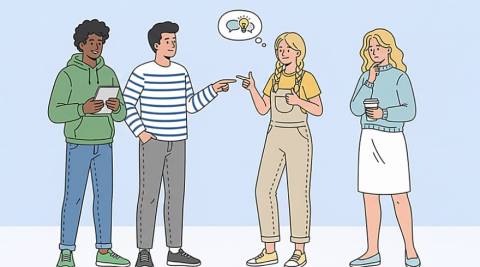The Complete Guide to the 4 Communication Styles: Definitions and Benefits

Why Communication Styles Matter More Than Ever
Every conversation leaves a residue that shapes trust, momentum, and outcomes. Teams rise or stall based on how they exchange ideas, ask for what they need, and respond under pressure. At home, tiny cues, tone, timing, and phrasing determine whether a simple request becomes a collaborative moment or a conflict. Understanding communication styles gives people a predictable lens to interpret behavior and choose responses that increase clarity while preserving relationships. Across workplaces and families, 4 types of communication styles often surface as predictable patterns that shape outcomes. When people can name the tendencies assertive, passive, aggressive, and passive-aggressive, they gain leverage to adjust in real time. That flexibility prevents misunderstandings, protects focus, and minimizes friction that would otherwise drain energy from goals. Leaders who model adaptable style choices invite psychological safety while still steering toward results.
In practice, a shared vocabulary reduces guesswork and discourages mind-reading. Instead of labeling a colleague as “difficult,” you can identify a behavior pattern, explore intent, and calibrate your response. This shift transforms hard moments into structured dialogues. In collaborative environments, 4 communication styles become a practical framework for feedback, conflict resolution, and decision-making that respects both people and performance.
- Clarity improves when intent and impact are visible to everyone.
- Collaboration deepens as assumptions are replaced by explicit agreements.
- Confidence grows because people know which behaviors lead to better outcomes.
What Are the Four Communication Styles?
The classic model distinguishes assertive, passive, aggressive, and passive-aggressive behaviors, each with trademark signals, strengths, and predictable risks. In research summaries, the phrase 4 types of communication shows up as shorthand for this enduring framework. While no one is a single category all the time, most of us have a default style under stress, and that default explains recurring dynamics across projects, friendships, and families.
Within academic handbooks, the 4 types of communication are frequently grouped by intent, clarity, and respect. Assertive style emphasizes clear boundaries and mutual benefit, passive style avoids conflict at the cost of needs, aggressive style pursues goals by overpowering others, and passive-aggressive style masks frustration through indirect resistance. Context matters: high-stakes emergencies may reward directiveness, whereas creative brainstorming benefits most from curiosity and shared air time.
| Style | Typical Behaviors | Strengths | Risks | Best Use |
|---|---|---|---|---|
| Assertive | Direct language, calm tone, clear boundaries | High trust, efficient decisions, mutual respect | May feel blunt to highly sensitive listeners | Feedback, negotiations, setting expectations |
| Passive | Hesitant voice, defers to others, avoids requests | Low conflict in the short term, accommodating | Unmet needs, hidden resentment, ambiguity | Gathering input, listening, de-escalation |
| Aggressive | Interruptions, commanding tone, pushes urgency | Fast action, clear direction in crises | Fear, disengagement, limited creativity | Urgent decisions, safety issues, clear calls |
| Passive-Aggressive | Sarcasm, delays, indirect resistance | Signals problems without open conflict | Erodes trust, confuses priorities, stalls work | Flag for unresolved issues needing dialogue |
Assertive
Assertiveness pairs clarity with respect. People using this style state needs, set boundaries, and invite dialogue. The tone is steady, the language is specific, and the intent is collaborative. When combined with curiosity, this style fuels rapid learning and constructive conflict.
Passive
Passivity avoids friction but often at the expense of personal needs. Silence, softening language, and quick agreement can soothe tension temporarily. Over time, however, unspoken concerns surface as disengagement or burnout unless the pattern is addressed openly.
Aggressive
Aggression prioritizes speed and control. It can cut through confusion in crises but risks long-term damage to morale. When urgency ends, continued forcefulness suppresses dissent and narrows creativity, leading to brittle outcomes that fail under new constraints.
Passive-Aggressive
Passive-aggression signals frustration without naming it directly. Sarcasm, foot-dragging, and mixed messages spread ambiguity. The antidote is candor with compassion naming the issue, sharing impact, and co-creating next steps that restore clarity.
Benefits of Mastering Style Flexibility
Adapting to context beats clinging to a single default. The most effective communicators know when to state boundaries, when to ask open questions, and when to slow down to include quieter voices. That range creates resilience: teams handle difficult conversations earlier, surface risks faster, and land decisions that people will actually support after the meeting ends.
For training curricula, 4 basic styles of communication provide a clean scaffold for lesson design. A clear model helps participants practice specific moves: saying no without drama, inviting dissent productively, or shifting from directives to questions during exploration. In performance environments, measurable habits summarizing agreements, labeling emotions responsibly, setting time-boxes convert theory into repeatable results.
In change management, 4 styles of communication help leaders anticipate friction and prevent misalignment. When stakes rise, preemptive agreements about tone, turn-taking, and escalation paths lower the temperature. That shared structure enables healthy candor, which, in turn, reduces costly rework and speeds up execution without sacrificing relationships.
- Faster alignment because expectations are explicit and tracked.
- Lower stress through boundaries that protect focus and energy.
- Greater inclusion by balancing airtime and inviting diverse input.
- Stronger accountability via clear requests, owners, and timelines.
How to Identify Your Predominant Style
Self-awareness starts with noticing patterns under pressure: what happens to your tone, body language, and word choice when deadlines loom or feedback feels personal? People often have one default at work and another at home, which means context is a variable worth examining. Tracking triggers helps separate the event from your response, opening space to choose a different move next time.
When reflecting on meetings, 4 different communication styles can be spotted by tone, pace, and boundary-setting. Listen for how often you qualify statements, whether you ask or tell, and how you handle interruptions. Also watch for internal cues tight shoulders, shallow breathing, or a racing mind that hint your nervous system is driving the dialogue more than your intentions are.
For self-discovery, a printable 4 communication styles worksheet guides people to log triggers, reactions, and alternative responses. Combine journaling with short reflection blocks after key interactions. A simple loop observe, label, choose, and debrief builds skill quickly, especially when paired with gentle accountability from a peer coach or manager who can spot blind spots in real time.
- Record three moments a day where your style shifted noticeably.
- Note what you wanted, what you said, and how it landed with others.
- Draft one alternative sentence you could try next time.
- Rehearse aloud to make new patterns feel natural under stress.
Practical Strategies to Improve and Flex
Skillful communication is a stack of small behaviors practiced with intention. Start by aligning your purpose with the moment: are you informing, exploring, deciding, or repairing? The answer guides tone, structure, and pacing. Next, calibrate for the audience’s bandwidth and preferences, then choose formats live, async, written that minimize noise and maximize shared understanding.
During coaching sessions, 4 types of communication become a shared map for practicing healthier responses. A useful pattern is “Pause, Purpose, Plan”: stop to breathe, clarify the outcome you want, and choose language that is both direct and kind. That sequence slows reactivity, helping you replace reflexes with deliberate responses that move the conversation forward.
Across cross-cultural projects, 4 main types of communication serve as a neutral vocabulary for feedback. To expand your range, experiment with micro-skills: using “I” statements to own impact, inviting a counterpoint before deciding, summarizing agreements, and naming trade-offs explicitly. Over time, those moves shrink drama and grow momentum because they reduce ambiguity while honoring autonomy.
- For assertiveness: pair clear requests with options and timelines.
- For passivity: script boundary phrases you can deliver calmly.
- For aggression: channel urgency into facts, not assumptions.
- For passive-aggression: translate subtext into direct, respectful language.
FAQ: Common Questions About Communication Styles
What are the four styles called, and why do they persist across contexts?
The enduring labels are assertive, passive, aggressive, and passive-aggressive, and they persist because they capture recognizable patterns of intent and behavior. These categories help teams discuss impact without moralizing, which keeps the focus on outcomes and relationships instead of character judgments.
Are people stuck with one default style forever?
Defaults are habits, not destinies. With practice, people can widen their range, learn triggers, and choose different responses. Real change comes from small, repeatable behaviors measured over weeks, not from a single conversation or workshop.
Which style is “best” for leadership and high-stakes work?
Assertiveness tends to produce durable trust because it balances clarity with respect, but the optimal choice depends on context. In fast crises, directiveness helps; in design sprints, curiosity wins; in repairs, empathy and responsibility matter most.
How can I learn the essentials quickly without getting overwhelmed?
In brief, 4 basic communication styles are widely taught as assertive, passive, aggressive, and passive-aggressive. A quick-start approach is to pick one micro-skill such as summarizing agreements, and practice it in every conversation for a week, then add another.
Is there a simple way to self-assess my tendencies before deeper training?
For a quick check, a short 4 communication styles quiz can give directional insights without replacing a full assessment. Pair any result with feedback from trusted peers who can describe how your words and tone land in real situations.
Latest News



